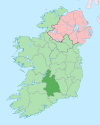Marlfield, Clonmel
Marlfield
Gort an Mharla | |
|---|---|
Village | |
IST (WEST)) | |
| Irish Grid Reference | S 1729 2182 |
Marlfield (
Local industry
Marlfield developed as a minor regional industrial centre using water from a tributary of the river
Marlfield/Abbey during the famine
In 1837, ten years before the height of the famine, Marlfield was recorded as having a population of 1,123 inhabitants, many of whom were employed at John Stein's distillery.[5] Like much of the rest of rural Ireland, the poor of Marlfield suffered greatly during the Great famine. While there were local acts of philanthropy to help alleviate starvation, there were documented cases where food convoys and barges transporting flour and grain were attacked by desperate residents. These incidents of 'lawlessness' were viewed with little sympathy by local establishment figures.[6]
Sport
The village is home to Marlfield GAA club, which promotes hurling in the area.
In 2009 Marlfield was the start and finish points for the 'Bill Hyland Memorial' cycle race. This is a road event organised annually by the Clonmel Cycle Club.[7]
People associated with Marlfield
- John Philip Bagwell (1874–1946) General manager of the Great Northern Railway, MP and Irish Free State Senator.
- Richard Bagwell (1840–1918) Historian and Unionist MP.
- Theo English (1931 - 2021) Retired Sportsperson, played hurling with Marlfield and the Tipperary team.
Points of local interest
- Marlfield House. Burned by anti-Treaty Republicans in January, 1923, and subsequently rebuilt.[8]
- St. Patrick's Church.
- Marlfield Lake. Artificial reservoir fed by springs at St. Patrick's Well, it was used to supply power to local mills. It is now a wildlife sanctuary and public amenity.[9]
- St. Patrick's Well [1]
- Sandybanks. Formerly a favourite swimming area on the Suir. During summer holidays, large crowds from Clonmel made their way here to swim before the provision of the town's first indoor pool in 1973.
- Memorial to local soldiers who died in the 1914-18 war.[2]
Gallery
-
Marlfield house, formerly the seat of the Bagwell dynasty.
-
View of St. Patrick's church from the village.
-
Marlfield lake, a wildlife sanctuary.
-
View of nearby St, Patrick's well.
See also
References
- ^ Young, Arthur (1780). A Tour in Ireland;. Dublin: Printed by G. Bonham for Whitestone. p. 141.
- ^ Morewood, Samuel (1838). A philosophical and statistical history...of inebriating liquors... W. Curry, jun. and company.
- ^ Great Britain. Parliament. House of Commons (1818). Parliamentary papers. HMSO.
- JSTOR 30008003.
- ^ Lewis, Samuel (1837). A Topographical Dictionary of Ireland: Comprising the Several Counties etc. S. Lewis.
- ^ Pownoll Phipps, William (1894). Life of Colonel Pownoll Phipps, with family records. London: R. Bentley. pp. 171–174.
- ^ "Clonmel Race Route !". Worldwidecycles.com. April 2009. Retrieved 15 March 2010.
- JSTOR 30008301.
- ^ . Belton, S (1834). The Angler in Ireland: Or An Englishman's Ramble Through Connaught and Munster, During the Summer of 1833. R. Bentley. p. 23.
Marlfield, Clonmel.





